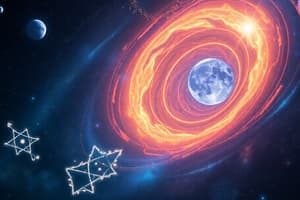Podcast
Questions and Answers
What type of elements are fused into heavier elements like carbon and oxygen in the later stages of a star's life cycle?
What type of elements are fused into heavier elements like carbon and oxygen in the later stages of a star's life cycle?
- Carbon and oxygen (correct)
- Hydrogen and helium
- Nitrogen and sulfur
- Iron and nickel
Which type of star has exhausted its nuclear fuel in the core and begun fusing heavier elements, such as carbon and oxygen?
Which type of star has exhausted its nuclear fuel in the core and begun fusing heavier elements, such as carbon and oxygen?
- Red Super Giant (correct)
- White Dwarf
- Red Giant
- Blue Supergiant
What is the final evolutionary phase of an original star where it gradually cools and fades?
What is the final evolutionary phase of an original star where it gradually cools and fades?
- Super Giant
- Neutron Star
- Black Dwarf (correct)
- Magnetar
What happens during a supernova that leads to the formation of heavy elements like gold and uranium?
What happens during a supernova that leads to the formation of heavy elements like gold and uranium?
What is a black hole's defining characteristic that makes it impossible for anything, not even light, to escape?
What is a black hole's defining characteristic that makes it impossible for anything, not even light, to escape?
What is a protostar?
What is a protostar?
What initiates the process of nuclear fusion in a protostar?
What initiates the process of nuclear fusion in a protostar?
What differentiates massive stars from average stars in terms of lifespan?
What differentiates massive stars from average stars in terms of lifespan?
What happens when hydrogen atoms within the core of a star combine to form helium?
What happens when hydrogen atoms within the core of a star combine to form helium?
What is a red giant?
What is a red giant?
Flashcards are hidden until you start studying
Study Notes
Star Life Cycle
- A star begins to fuse helium into heavier elements like carbon and oxygen as it ages and runs out of hydrogen fuel in its core.
Red Super Giant
- A red super giant is a massive star in the later stages of its life cycle that has exhausted its nuclear fuel in the core.
- It fuses heavier elements, such as carbon and oxygen, into even heavier elements like iron.
Planetary Nebula
- As the star expands, gravity can no longer hold on to the star's surface, and the star loses layers until only the core remains.
- The radiant, expanding cloud of ionized gas showcases breathtaking colors and shapes, imparting an ethereal beauty to the cosmos.
White Dwarf
- At the heart of the planetary nebula lies the remnant core of the star, now a white dwarf.
- This dense, Earth-sized stellar remnant gradually cools and fades, marking the final evolutionary phase of the original star.
Black Dwarf
- Nuclear fusion ceases in the white dwarf, and it gradually cools over billions of years, eventually transitioning into a black dwarf.
- This phase marks the conclusion of the luminous energy-producing aspect of the star's existence.
Super Nova
- An aging high-mass star experiences gravitational collapse, triggering an explosive rebound known as a supernova.
- During a supernova, the extreme temperatures and pressures lead to the formation of heavy elements, including gold, silver, and uranium.
Neutron Star
- A neutron star exhibits rapid rotational periods and emits beams of electromagnetic radiation, known as pulsars.
- A type of neutron star with extraordinarily powerful magnetic fields, leading to intense gamma-ray bursts and X-ray emissions, is known as a magnetar.
Black Hole
- A black hole is a region in space where the gravitational pull is so strong that nothing, not even light, can escape from it.
- Black holes exist in a variety of sizes, ranging from stellar-mass black holes generated by the collapse of huge stars to supermassive black holes located at galaxies' cores.
Star Formation
- Star formation begins with a stellar nebula, a vast cloud of gas and dust.
- Gravity causes the material to condense and clump together, forming a protostar.
- A protostar is a very young star that is still gathering mass from its parent stellar nebula.
Nuclear Fusion Ignition
- As the protostar continues to accumulate mass, its core becomes denser and hotter, initiating the process of nuclear fusion.
- Once the core temperature reaches millions of degrees, nuclear fusion ignites, marking the birth of a star.
Stable Energy Production
- A star continuously converts hydrogen to helium via nuclear fusion, releasing an immense amount of energy in the form of light and heat.
- This constant energy output powers the star, allowing it to maintain a stable size and temperature while emitting a consistent quantity of light.
Types of Stars
- An average star, like the Sun, is characterized by its stable energy output and balanced internal forces.
- Massive stars are much larger, with masses greater than about 8 times the mass of the Sun, and have short lifespans.
- Red giants are stars with a mass similar to that of the Sun, in a stage of their life cycle.
Studying That Suits You
Use AI to generate personalized quizzes and flashcards to suit your learning preferences.




